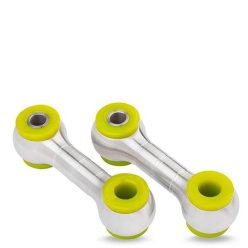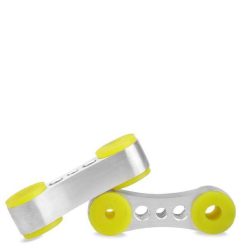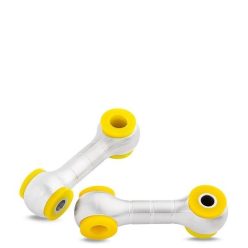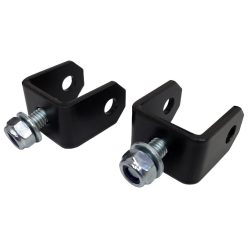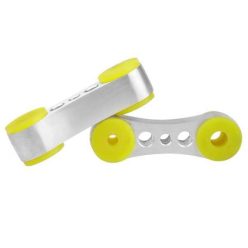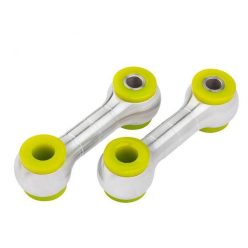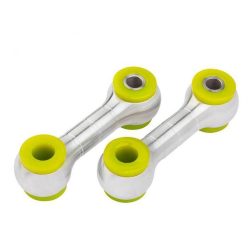Sway bar links connect the anti-roll bar to the suspension arms or struts, so they have a direct impact on body roll and cornering stability. In this category you will find fixed-length and adjustable sway bar links with high-strength rod ends in various lengths and thread sizes, ideal for lowered, track and drift setups. Upgraded links reduce play, improve steering response and help maintain correct suspension geometry under high lateral loads, especially when combined with stiffer anti-roll bars and coilovers.
Net price: 122 €
Net price: 122 €
Net price: 84 €
Net price: 122 €
Net price: 26 €
Net price: 18 €
Net price: 18 €
Net price: 92 €
Net price: 119 €
Net price: 92 €
Net price: 119 €
Net price: 92 €
Function and Benefits of Sway Bar Links
Sway bar links (anti-roll bar links) are a small but critical part of the suspension, transferring force between the anti-roll bar and the suspension arms or struts. Worn or flexible OE links can introduce play, knock over bumps and allow the body to roll more than intended, reducing precision and confidence. Upgraded sway bar end links with stiffer construction and quality joints keep the bar working as designed, sharpening turn-in, improving mid-corner stability and making the car’s responses more consistent—especially when springs, dampers and tyres have already been uprated.
On lowered, track or drift cars, sway bar link length and strength become even more important. Lowering often rotates the anti-roll bar away from its neutral position, effectively pre-loading it on one side. This can create asymmetric handling—one direction feels different to the other—and unexpected behaviour at the limit. Adjustable links allow you to dial the bar back to a neutral position at your chosen ride height, fine-tune balance and extract the most from your anti-roll bar package.
Technical Basics
A typical sway bar link is a short rod with joints at each end, connecting the anti-roll bar to the control arm, strut or knuckle. OE links often use plastic or rubber-isolated ball joints to reduce noise and vibration, but these components soften and wear over time. Performance-oriented links generally use metal-encased ball joints or motorsport-style rod ends (uniballs) with stronger shanks and threads, reducing deflection under load. In adjustable designs, the centre section is threaded or uses opposing threaded ends so that length can be changed by rotating the body.
Materials typically include high-tensile steel or lightweight aluminium alloys with corrosion-resistant coatings. Joint housings are sealed with dust boots to keep grease in and contamination out, as the environment near the wheel is harsh—exposed to water, salt, grit and heat. Common thread sizes are metric (M10, M12, M14) as well as some imperial patterns on specialised kits. It’s essential that the link matches the anti-roll bar and suspension pick-up points in both diameter and thread specification to avoid looseness or stress concentrations.
Adjustable sway bar links offer additional benefits when combined with multi-hole adjustable anti-roll bars. By trimming link length you can ensure the bar is not pre-loaded at static ride height, and—on some chassis—subtly bias the bar for fine corner-weight tuning. However, adjustments must be made carefully and symmetrically; excessive length differences or misalignment can lead to binding, premature joint wear or unpredictable handling.
Selection Criteria
When choosing sway bar links, start by mapping your suspension layout and mounting points. Determine whether the bar connects directly to the control arm, the strut or an intermediate bracket and measure the original eye-to-eye link length. This gives a baseline for selecting a fixed-length replacement or setting an adjustable link’s initial length. Also confirm bolt diameters and thread type—mixing M12x1.25 and M12x1.5, for example, will cause installation issues and potential safety problems.
Next, consider usage: daily road, mixed street/track or pure motorsport. For road-biased cars, reinforced OE-style links with sealed ball joints strike a good balance between precision and comfort. For track, time-attack or drift, solid rod-end style links with PTFE-lined joints offer sharper response and better durability at high loads, at the cost of a little extra noise and harshness. If you run adjustable anti-roll bars or have significantly altered ride height (coilovers, big drops), adjustable end links are highly recommended to avoid pre-load and to keep the bar geometry in its optimal working range.
Think of sway bar links as part of an overall suspension package. Stiffer bars, uprated springs, camber plates and performance tyres all interact; over-stiffening one end of the car with a big bar and solid links while leaving the other end soft can cause strong understeer or oversteer. Ideally, you choose link stiffness and adjustability to complement your choice of bars and alignment settings rather than in isolation.
Installation & Maintenance
Replacing sway bar links is usually straightforward, but technique matters. Whenever possible, tighten the link fasteners at or near normal ride height so the anti-roll bar is not twisted when the car is sitting on its wheels. This helps prevent unwanted pre-load. Always use proper torque values and, where specified, new self-locking nuts. On adjustable links, ensure that sufficient thread engagement remains on both ends—if too much thread is exposed on one side, the link may buckle or strip under heavy load.
During installation, make sure links are not forced into a misaligned position at full droop or full compression. Check clearance around drive shafts, brake hoses and chassis components throughout the suspension travel range. On adjustable assemblies, lock nuts must be securely tightened once the final length is set, and it’s good practice to mark their position with paint so any movement can be spotted during inspections.
For maintenance, listen for knocks and clunks over small bumps and speed humps—these are common signs of worn or loose sway bar links. Periodically jack the car up and check for play by moving the link by hand; any noticeable rocking or clicking at the joints means replacement is due. Torn dust boots should not be ignored, as contamination will quickly destroy even high-quality joints. For track and drift cars, incorporate link inspection into your routine pre- and post-event checks along with other critical suspension hardware.
FAQ
What are the typical symptoms of worn sway bar links?
Common signs include clunking or knocking noises over small bumps, vague or delayed steering response and a feeling that the car leans more in corners. On inspection, worn links will usually show visible play when you push or pull on the bar or the link body.
Do I need adjustable sway bar links on a lowered car?
Adjustable end links are highly recommended on lowered cars, especially when combined with stiffer bars. They allow you to remove unwanted pre-load from the anti-roll bar at your chosen ride height, which restores predictable balance and lets the bar work as intended.
Are spherical-bearing sway bar links too harsh for street use?
Rod-end or spherical links do transmit more noise and vibration than soft OE joints, but in many cases they are still acceptable for fast road use. If comfort is a priority, choose sealed ball-joint links designed for performance street applications rather than full race-spec hardware.
Will I need an alignment after changing sway bar links?
Simply replacing fixed-length links with equivalents usually does not require a new alignment. However, if you change ride height, fit adjustable links or make other suspension changes at the same time, a proper alignment check is advisable to ensure geometry is still within spec.
How often should sway bar links be replaced?
There is no fixed mileage interval, as life depends heavily on road quality and driving style. Street cars on rough roads and hard-driven track or drift cars will wear end links faster. Any sign of play, boot damage or persistent noise means it’s time for replacement regardless of kilometres covered.


